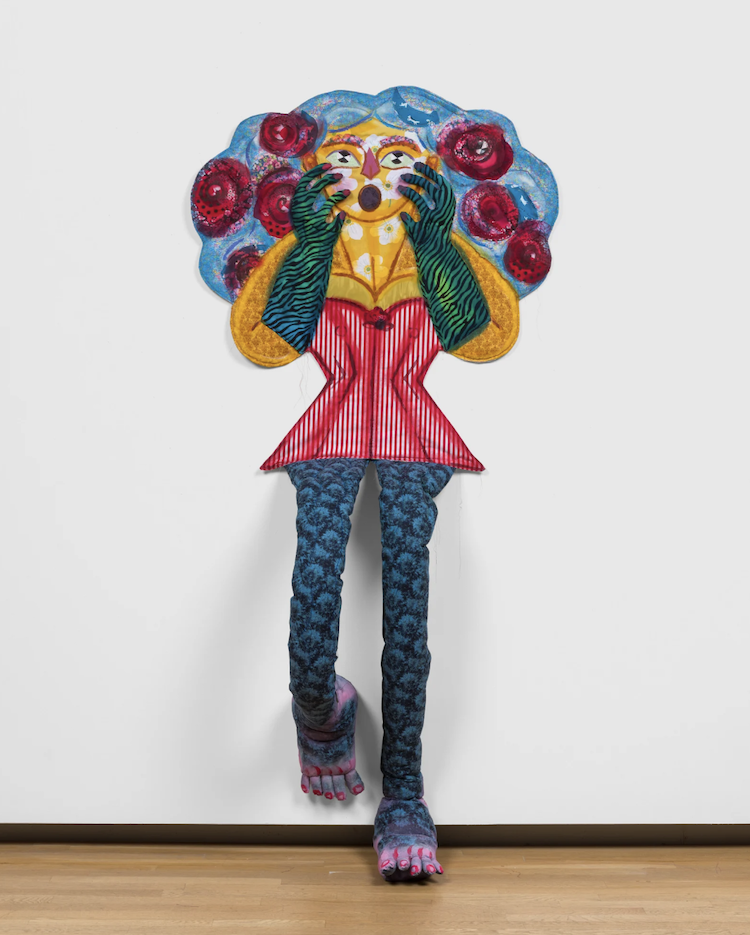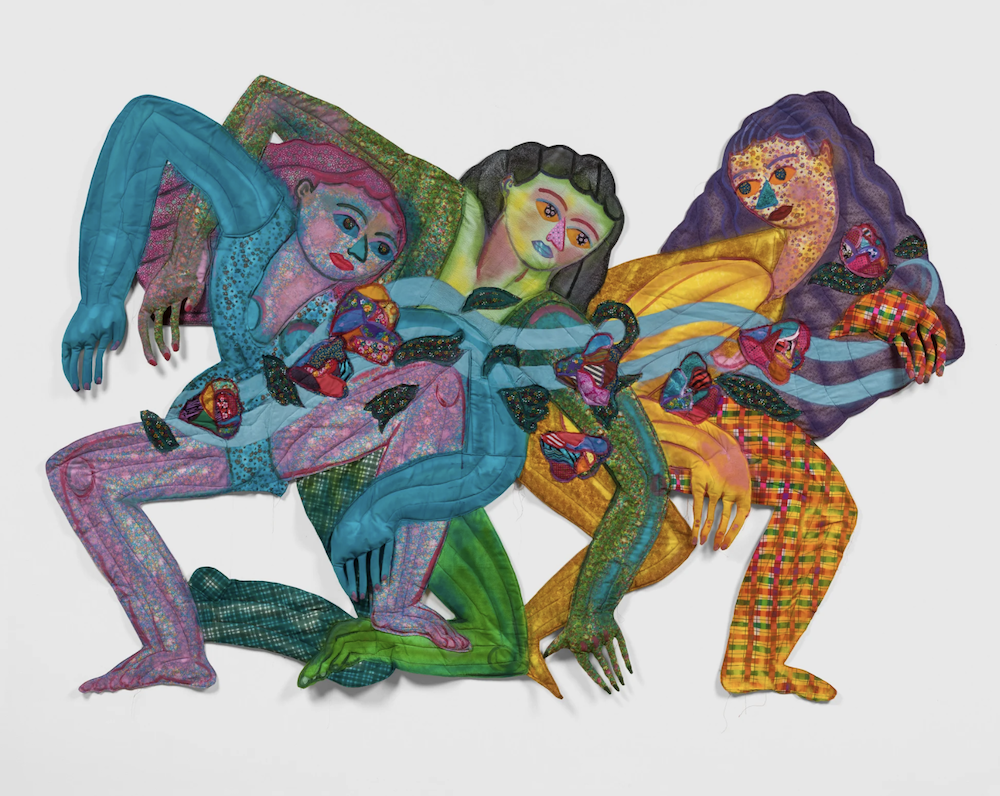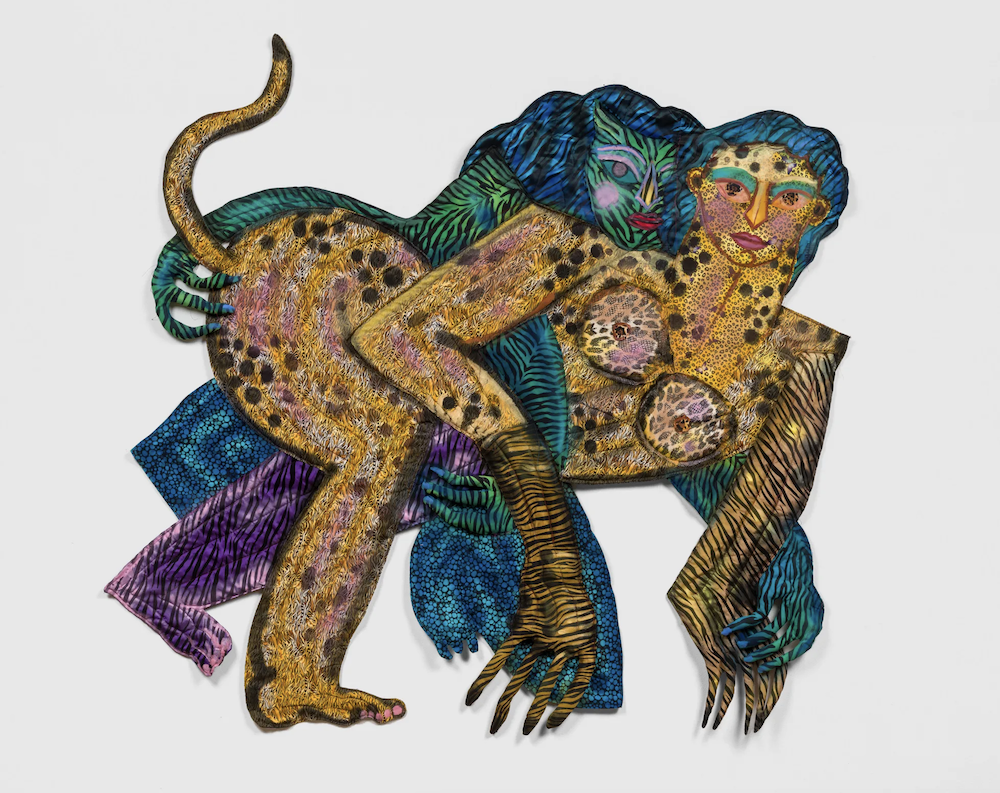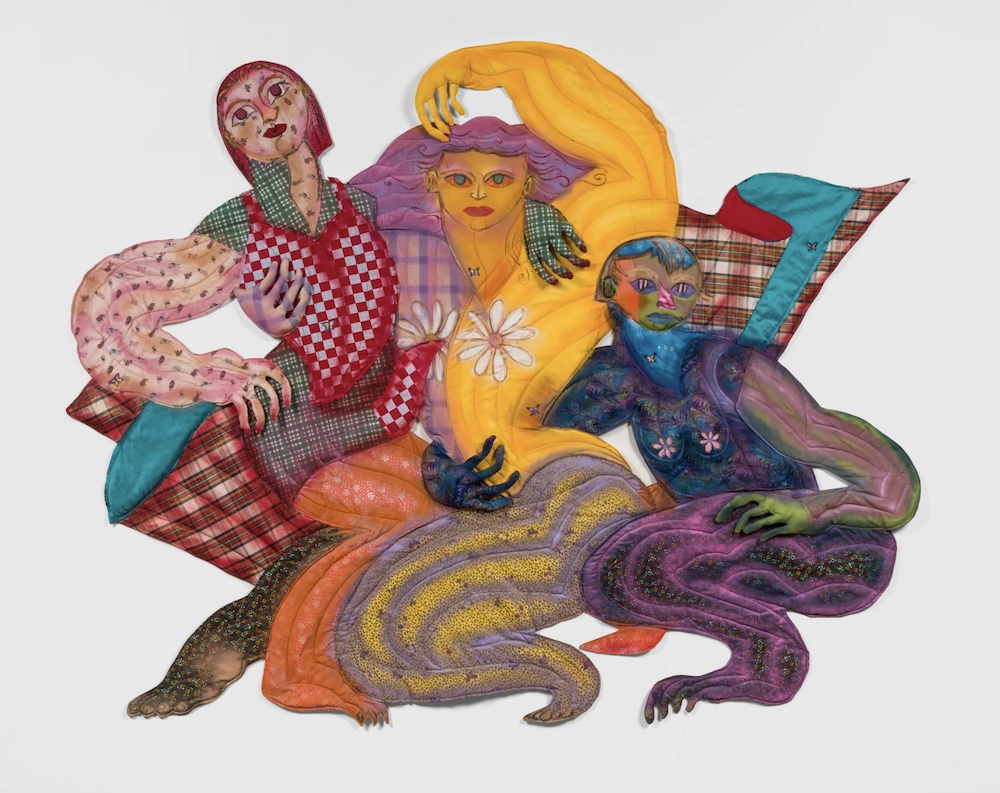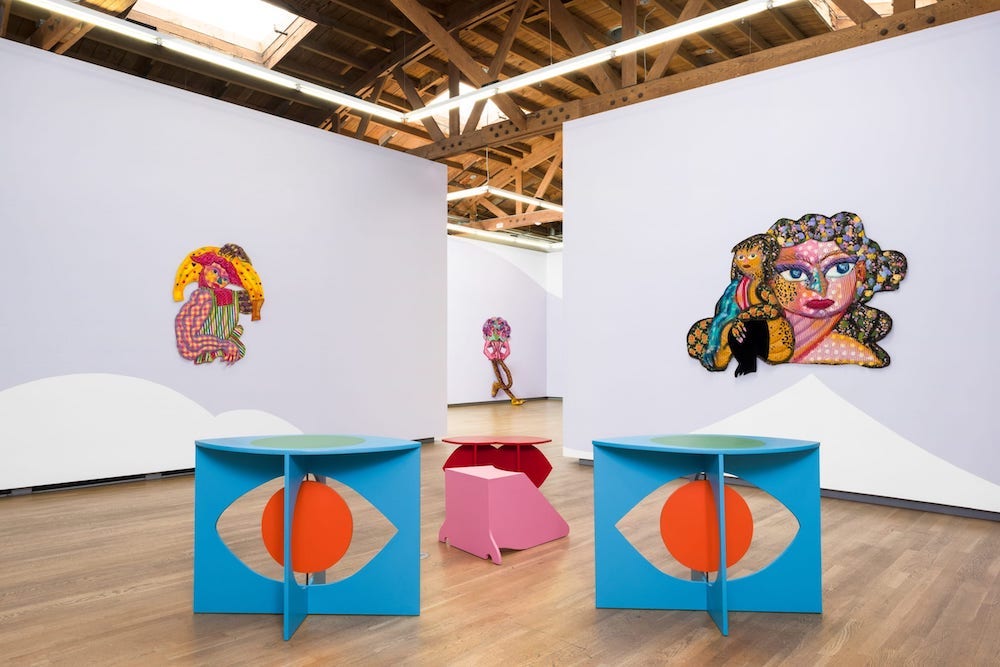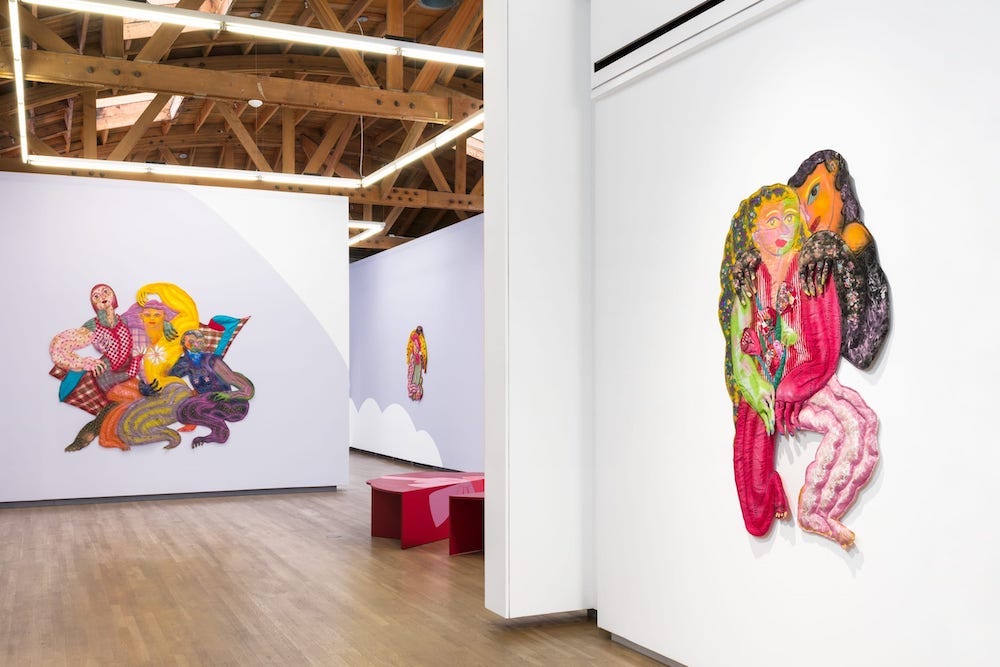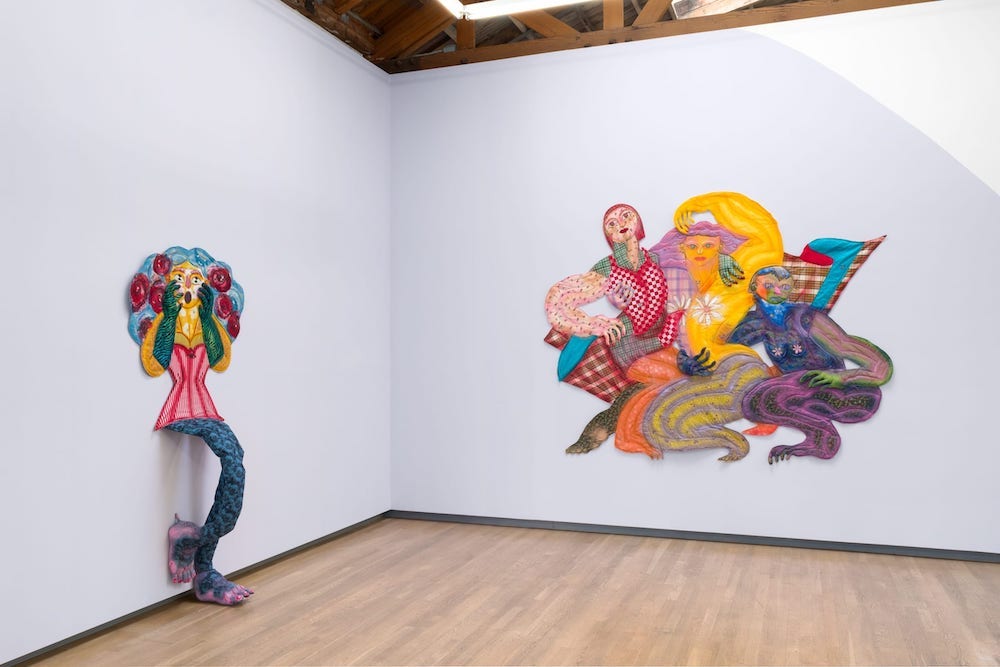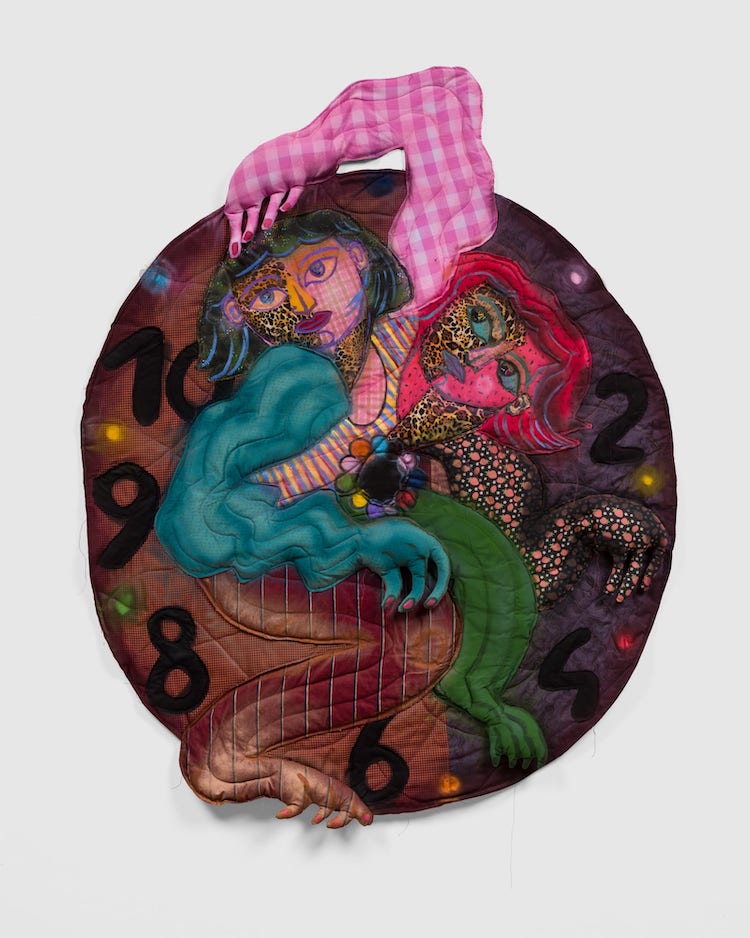Shulamit Nazarian, Los Angeles is pleased to announce a solo exhibition of new quilted, stitched, and painted textile wall works, alongside custom functional sculptures, by Oakland-based artist Maria A. Guzmán Capron.
For her second solo exhibition with the gallery, Capron draws from the beyond-believable narratives of the telenovela, presenting new works united through the title Pura Mentira, a Spanish-language expression, directly translating to pure lie. Capron shares, “This body of work centers on the concept of lies, small colloquial distortions of reality, as the catalyst for experimentation, role play, and the loss of inhibition.”
Under the banner of lies, the artist brings the extraordinary potential of her surreal figures into the realm of daily life. Rather than casting judgment on dishonesty, she approaches the subject with empathy, embracing the many ways we all use lies to distort the reality of mundane scenarios as simple as running late. She celebrates the power of these subtle everyday moments, allowing them to become bridges to a hospitable space that not only permits but also encourages an indulgence in hyperbolic experiences. The artist states, “The pieces build on the themes of the embodiment of multitudes to open to alternate, unruly narratives. Pura Mentira is a work of fiction in which passion, guilt, and secrets reign freely.”
Joining together a spectrum of colors and clashing patterns to construct bodily forms, Capron’s practice explores cultural hybridity, a non-binary sense of self, and the competing desires to assimilate and to be seen. Born in Milan, Italy to Colombian and Peruvian parents and later relocating to Texas as a teenager, the artist recognizes the challenges of toggling between various cultures and geographies and the impact this has on one’s sense of self. Rooted in her personal experiences, often drawing directly from her most intimate relationships, her work offers a physical manifestation of the polyvalent influences that shape us—from our cultural identities, experiences, and communities to our desires, distastes, vices, and virtues. Capron’s multilayered textile works emphasize that as individuals we consist of several identities, some that we repress and some that we exalt.
Capron’s fiber works are constructed from an extensive palette of vibrant and often playfully patterned fabrics. Collaged, sewn, stuffed, and quilted together, the artist finishes each piece with a mix of acrylic, spray, and latex paints. Using both fabric and paint to define the features and dimensions of the figures, the final mélange of faces and limbs have a fluctuating relationship with each other. Exaggerated body parts —signature moves in Capron’s work—render muscular arms, puffy fingers, and slinky legs that intertwine to become one. By design, it’s not readily apparent where one figure begins and another ends. Her works highlight the diversity within many of us, where several individual personas assembled together can be understood as reflections of a single person. Capron thinks of identity as something that constantly shifts and evolves, constructing figures that are simultaneously extensions of herself and collective portraits of those who often influence identity formation, such as lovers, caretakers, and friends.
Upon entering the space of the exhibition, we see the individual fiber works in Pura Mentira are held by oversized curling limbs in an open embrace, painted directly on the gallery walls. This abstracted body stretches across the walls in each room of the exhibition, with some features appearing in sculptural form. The figure culminates in the final room to reveal the face of this giantess, the eyes in the form of tables and nose and mouth in the form of seats. In the central gallery, an open heart, made from two curving crimson benches, has been placed inside the torso. These gestures not only constitute a single creature housing the multitude of personas occupying the walls in the artist’s fiber works, but also act as a welcoming invitation for visitors to travel through this body, to rest within its heart facing one another, to take up time and space. Though their presence dominates Pura Mentira, we cannot see the totality of this oversized figure; instead, their presence builds slowly as we move throughout the exhibition.
Pura Mentira systematically positions visitors within this compositional logic, inviting them to experiment with their internal and external influences to draw out latent personas buried within. The artwork Desátame dramatizes this almost literally. The central figure appears in a crouched position, ready to spring into action. Their hair billowing behind them and one arm reaching above, they appear with utmost strength and confidence, while two flanking figures wrap their arms around—one alien-like figure at the waist and another traditionally-femme figure at the shoulder—pulling in opposite directions. This trio exudes the pageantry of Pura Mentira while showing a figure simultaneously embracing and pulling away from different influences.
At its core a celebration of self-expression and existence beyond binary systems, Capron intentionally structures her works from fibers due to the materials' culturally inherited referentiality. Acknowledging fabric as a social marker of class, gender, and cultural identity, she fuses luxurious fabrics like silk with recycled, and off-cut, materials such as cotton and nylon. With this gesture, Capron levels the very materials that are designed to signal a hierarchy of wealth and exclusivity. In addition to serving as a metaphor for society’s inequities, her use of mainstream and mass-market materials functions as a subversive act to challenge the homogenizing capitalist landscape. Enlisting an intentional range of materials readily accessible to all, Capron demonstrates that the very fabrics used to reinforce hierarchies of class can instead be used to dismantle them while staging a space for difference to thrive.
Speaking to the concepts explored in Pura Mentira and the telenovelas consumed in her youth, Capron states, “Within these works, we recognize ourselves, our passions, our faults, and desires… but here they are extra. This is a space to push our boundaries—I want the close-ups, the makeup, the fashion. Sexy, dangerous, femme identities. Sweaty, hairy masculinity. Intrigue, whispers, secrets. Plot twists and Spanish gasps. The end of purity—a space full of guilt and, because of it, pleasure.” Ultimately, Pura Mentira is an invitation to join its players in performative gestures, expanding our boundaries and embracing our ineffable qualities, all while deepening our sense of empathy and acceptance.



